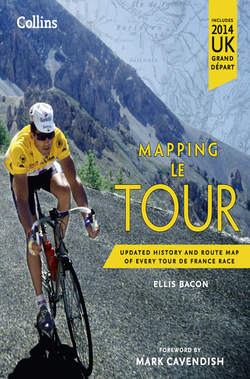Читать книгу Mapping Le Tour: The unofficial history of all 100 Tour de France races - Ellis Bacon - Страница 31
Оглавление1927
21st Edition
| Start: Paris, France, on 19 JuneFinish: Paris, France, on 17 July | |
| Total distance: 5320 km (3306 miles)Longest stage: 360 km (224 miles) | |
| Highest point:Col du Galibier: 2556 m (8386 ft)Mountain stages: 6 | |
| Starters: 142Finishers: 39 | |
| Winning time: 198 h 16’ 42”Average speed: 27.244 kph (16.928 mph) | |
| 1. Nicolas Frantz (Lux)2. Maurice De Waele (Bel) at 1 h 48’ 21”3. Julien Vervaecke (Bel) at 2 h 25’ 06” |
Francis Pélissier’s older brother, Henri, had done little to impress Tour organiser Henri Desgrange over the years. The two were almost permanently at loggerheads over how tough the race was – Henri the rider believing that it was too hard; organiser Henri always on the hunt for something to make it even harder. Even Henri’s 1923 victory displeased the race founder: it meant he had to put Pélissier on the cover of his newspaper.
One can only imagine, then, Desgrange’s feelings when Francis Pélissier became the first rider to quit the Tour while clad in the by-now hallowed yellow jersey. He was simply unable to match the speed set by his Dilecta-Wolber team-mates on stage 6 – one of the race’s many team time trials – and waved them onwards once it all became too much. It was in fact a good call: his team-mate, Ferdinand Le Drogo, took yellow in Brest that evening, although, by the end of the ninth stage, the whole eight-man team had quit the race.
It’s a dubious ‘honour’ for the young Pélissier to hold. Only fifteen riders have ever abandoned while in the yellow tunic, Britain’s Chris Boardman being another, in 1998, with the latest being Michael Rasmussen at the 2007 Tour, thrown out by his Rabobank team for having lied on his UCI ‘whereabouts’ form about where dope testers would be able to find him. He told them Mexico; he was training in Italy.
Nicolas Frantz became the second rider from Luxembourg to win the race, following in the tyre tracks of 1909 champion François Faber.
Dinan, Vannes, Pontarlier and Charleville were used as stage starts/finishes for the first time in a race made up of a massive twenty-four stages, with sixteen of those run as team time trials, in which teams started at 15-minute intervals, confusing the spectators immensely. Sponsored teams – usually headlined by bicycle manufacturers – had only just begun to reappear following a number of financially difficult post-war years for the major bike brands, such as Alcyon, Dilecta and JB Louvet.
André Leducq (left) and Tour champion Nicolas Frantz (right)
